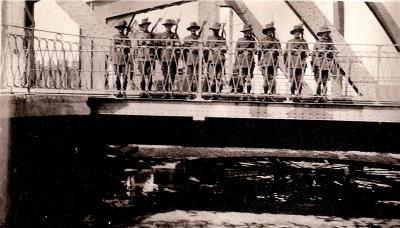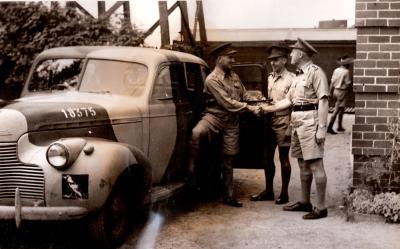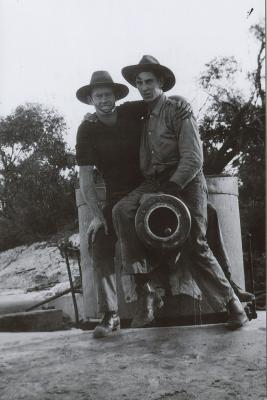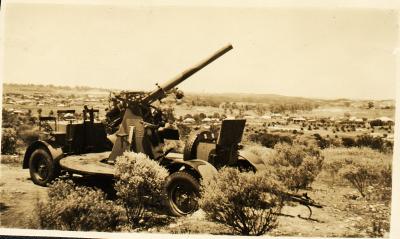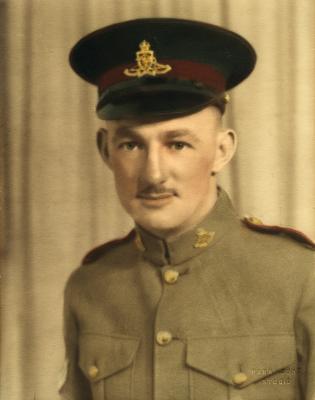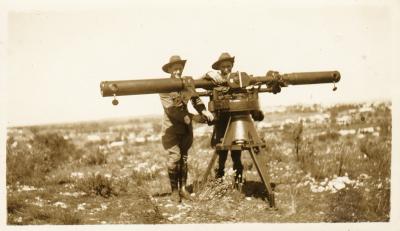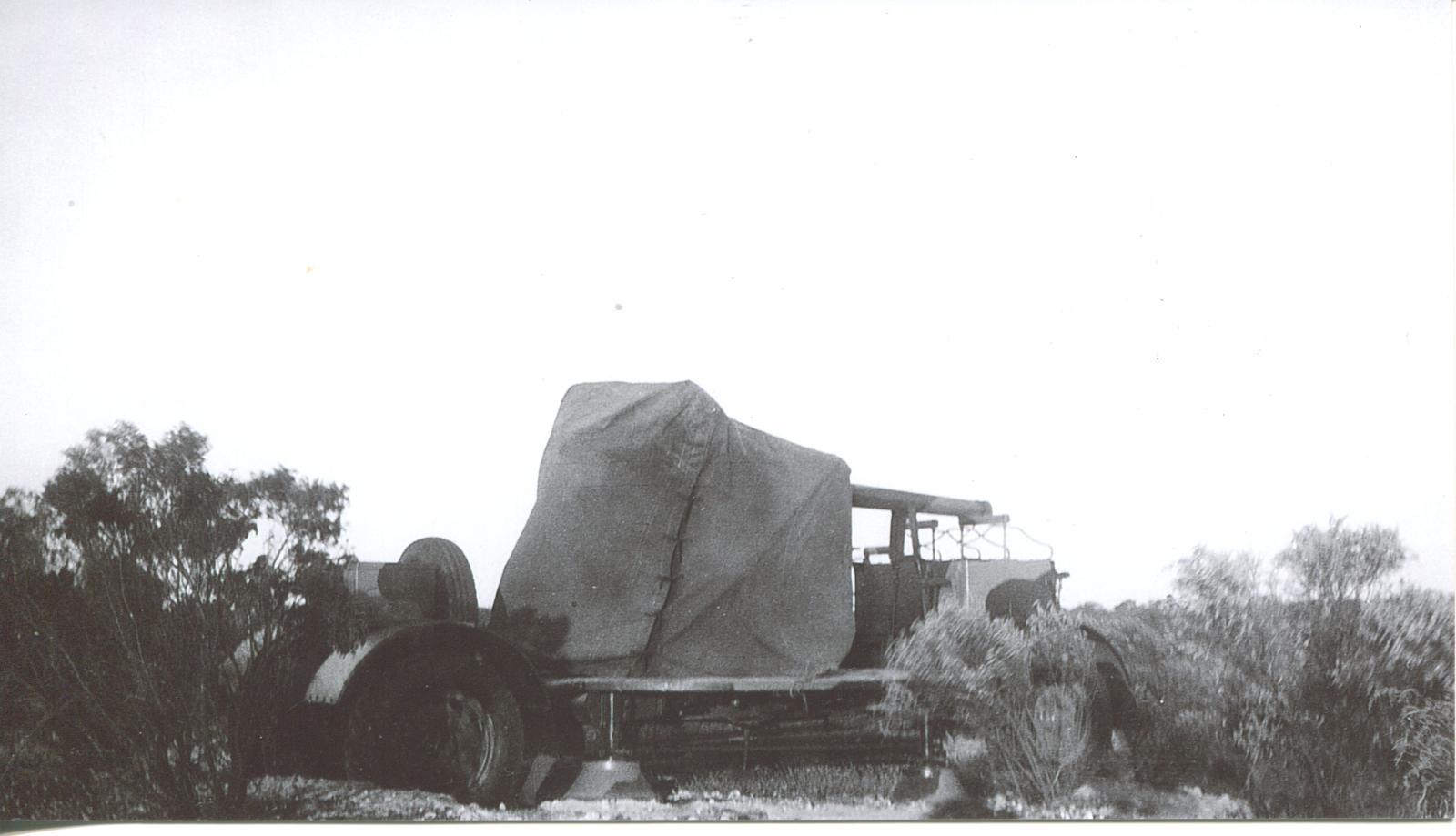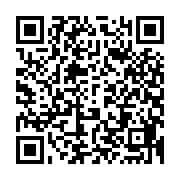World War 2, Australia, Western Australia, Fremantle 1939
1939View of Australian Army, 3 inch Heavy Anti-Aircraft gun, under cover, on Fremantle Golf Links
The QF 3 inch 20 cwt anti-aircraft gun became the standard anti-aircraft gun used in the home defence of the United Kingdom against German airships and bombers and on the Western Front in World War I. 20 cwt referred to the weight of the barrel and breech, to differentiate it from other "3 inch" guns (1 cwt = 1 hundredweight = 112 pounds, hence the barrel and breech together weighed 2240 lb).
Beginning in 1930, a new towed 4-wheeled sprung trailer platform was introduced to replace the obsolete lorries still used as mounts from World War I, together with modern new barrels, and equipment to connect the guns to the new Vickers No. 1 Predictor. By 1934 the rocking-bar deflection sights had been replaced by Magslip receiver dials which received input from the Predictor, with the layers matching pointers instead of tracking the target.[13] Predictor No. 1 was supplemented from 1937 by Predictor No. 2, based on a US Sperry AAA Computer M3A3. This was faster and could track targets at 640 km/h at heights of 25,000 feet,
With the start of World War II Australian 3 inch AA guns were emplaced around the defended ports and saw active service in Darwin, Rabaul and Port Moresby. They continued to be used throughout the war but were replaced in the active areas by the 3.7 inch anti-aircraft guns as they became available. They were withdrawn from service in 1945.
Details
Details
Prior to World War I the Royal Navy were the only service to consider defence against aircraft attack and developed the 3 inch High Angle Gun. With the advent of World War I the army realised the need for defence against aircraft and modified a number of field guns for the task. They also asked for a purpose built anti aircraft gun and saw the 3 inch HA gun as a suitable weapon but with modifications including semi-automatic operation of the breech mechanism. The Army version was designated 3 inch 20 cwt Anti aircraft gun and was mounted on a mobile carriage. Australia received four of these guns in 1927.
Australia planned to manufacture their own guns and by 1928 the Government Ordnance Factory had been built at Maribyrnong in Victoria and equipped with machinery bought from Great Britain. The factory was capable of manufacturing guns up to a calibre of 4 inches and the plan was to initially manufacture the 18 pounder field gun. Before work began the world-wide depression began to fall over Australia. Faced with the prospect of the factory having to close down and the loss of the expertise gathered over the past years, the administrators turned to the production of car components.
As Australia began to emerge from the depression the Ordnance Factory received its first order for guns from the Army. This order was for 24 of the 3 inch anti-aircraft gun which had been developed during World War I (1914-1918) and which by the 1930s had become the standard gun adopted by the British for ground defence against attack by aircraft. In the 1930s it had been modified to embody a new principle of gun construction known as autofrettage. This method of construction represented an important advance in gun design. Mr M.M. O’Loughlin, Works Manager of the Ordnance Factory was sent to Woolwich in 1934 to study the process. By the end of 1936 the autofrettage process had been well established at Maribyrnong and the first 3 inch gun, consisting of ordnance, mounting and four wheel travelling platform, was completed. Early in 1937 the first 3 inch gun successfully passed all its tests and was accepted by the Army.
Full production was achieved in November 1937 and proceeded at the rate of one equipment a month until January 1939 when it rose to two per month the order wascompleted in July 1939. These guns were fitted with a ‘Rocking bar’ sight, so that laying by telescope and Deflection and Fuze correction could be applied on the gun.
This successful production of the 3 inch anti-aircraft gun was an event of considerable historic importance since it marked the successful establishment in Australia of the technique of making guns. That the 3 inch gun was more or less obsolete by the time it was first made in Australia was not so serious as it might first seem. By making this gun the Ordnance Factory had gained experience that, in 1939, enabled it to turn with some confidence to the manufacture of the 3.7 inch anti-aircraft gun which had come into production in Britain in 1937.
One of these guns in the Royal Australian Artillery Museum (currently in storage while a new Museum is developed at Puckapunyal, Victoria) is the last example in Australia with its mobile carriage mounting. This gun is the only one of its type in Australia still on its mobile carriage.
Open in Google Maps
Nearest geotagged records:
- World War 2, Australia Western Australia Fremantle, 1939 (0km away)
- World War 2, Australia Western Australia Fremantle, 1939 (0km away)
- Inter War, Australia Western Australia, 1935 (0.16km away)
- World War 2, Australia Western Australia, 1939 (0.38km away)
- World War 1, Australia, Western Australia, 324 PARKINSON, 10 Light Horse (0.49km away)
- World War 2, Western Australia, Rottnest Island AIF Enlistment, WP6159 to WX34904 KING, 1942 (0.79km away)
- World War 1, Australia, Western Australia, 1378 CLARKE, 10 Light Horse (0.81km away)
- Not Forgotten, 2626 Lance Corporal Norman Henry SPEAKMAN, 43 Battalion AIF, World War 1 (0.92km away)
- World War 1, 53 HEATH, 10 Light Horse, 1914 (0.94km away)
- World War 1, Australia, Western Australia, 606 BROOKE, 10 Light Horse (1.05km away)
Nearby places: View all geotagged records »
Australian Army Museum of Western Australia
Australian Army Museum of Western Australia
Other items from Australian Army Museum of Western Australia
- World War 2, Australia, Western Australia, Albany, Princess Royal Fortress, 1939
- World War 1, Middle East Mansoura Bridge, 10 Australian Light Horse, 1919
- World War 2, Australia Western Australia, 3 Aust Corps, 11 Battalion, 1943
- World War 2, Australia, Western Australia, Princess Royal Fortress, Albany, 1939
- World War 2, Australia, Western Australia, Albany, Princess Royal Fortress, 1939
- World War 2, 1939
- World War 2, Australia Western Australia Fremantle, 1939
- World War 2, Australia Western Australia Fremantle, 1939
- World War 2, Australia Western Australia, 1939
- Inter War, Australia Western Australia Fremantle, 1935
- Inter War, Australia Western Australia, 1935
- Inter War, Australia Western Australia, 1935

